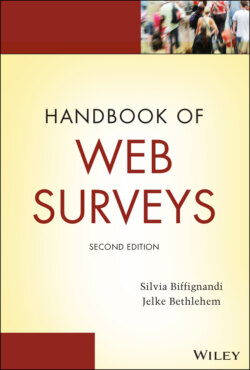Читать книгу Handbook of Web Surveys - Jelke Bethlehem - Страница 25
1.2.7 PRESENT‐DAY CHALLENGES AND OPPORTUNITIES
ОглавлениеIn the past 15 years, rapid technical and social changes have introduced a number of challenges and opportunities. The following is a high‐level list of challenges:
The respondent is much more in charge of the survey including whether and how he/she will participate.
There is such a vast proliferation of computing devices and platforms that survey takers cannot design and test for each possible platform.
Modern‐day surveys must be accessible to all self‐respondents, including the blind, visually impaired, and the motor impaired.
Few survey practitioners have all the skills needed to effectively design surveys for all platforms and to make them accessible at the same time.Pierzchala (2016) listed a number of technical challenges that face survey practitioners. This list was developed to communicate the magnitude of the challenges. The term multis refers to the multiple ways that surveys may have to adapt for a particular study:
Multicultural surveys: There are differences in respondent understanding, values, and scale spacing due to various cultural norms. These can lead to different question formulation or response patterns.
Multi‐device surveys: There are differences in questionnaire appearance and function on desktops, laptops, tablets, and smartphones.
Multilingual surveys: There are translations, system texts, alphabetic versus Asian scripts, left‐to‐right versus right‐to‐left scripts, and switching languages in the middle of the survey.
Multimode surveys: There are interviewer‐ and self‐administered surveys such as CATI and CAPI for interviewers and browser and paper self‐completion modes (Pierzchala, 2006).
Multinational surveys: There are differences in currency, flags and other images, names of institutions, links, differences in social programs, and data formats such as date display.
Multi‐operable surveys: These are differences in how the user interacts with the software and device including touch and gestures versus keyboards with function keys. Whether there is a physical keyboard or a virtual keyboard impacts screen space for question display.
Multi‐platform surveys: These are differences in computer operating systems, whether the user is connected or disconnected to/from the server, and settings such as for pop‐up blockers.
Multi‐structural surveys: There can be differences in question structures due to visual versus aural presentation, memory demands on the respondent, and linear versus nonlinear cognitive processing.
Multi‐version surveys: In economic surveys, questionnaires can vary between industries. For example, an agricultural survey asks about different crops in different parts of the country, and different crops can have different questions.
These multis lead to changes in question wording, text‐presentation standards, interviewer or respondent instructions, location of page breaks, number of questions on a page, question format, allowed responses, whether choices for don't know (DK) or refusal (R) are explicitly presented or are implied, and whether the user can advance without some kind of answer (even if DK or RF) or can just proceed at will to the next question or page.
There can be additional challenges. Governmental and scientific surveys can be long and complex. Surveys must be accessible and usable to the disabled.
Additionally, there are ever‐tightening constraints including not enough time, not enough people or money, unclear and late and inconsistent specifications, last‐minute changes, screens that are too small, and computers that are too slow.
